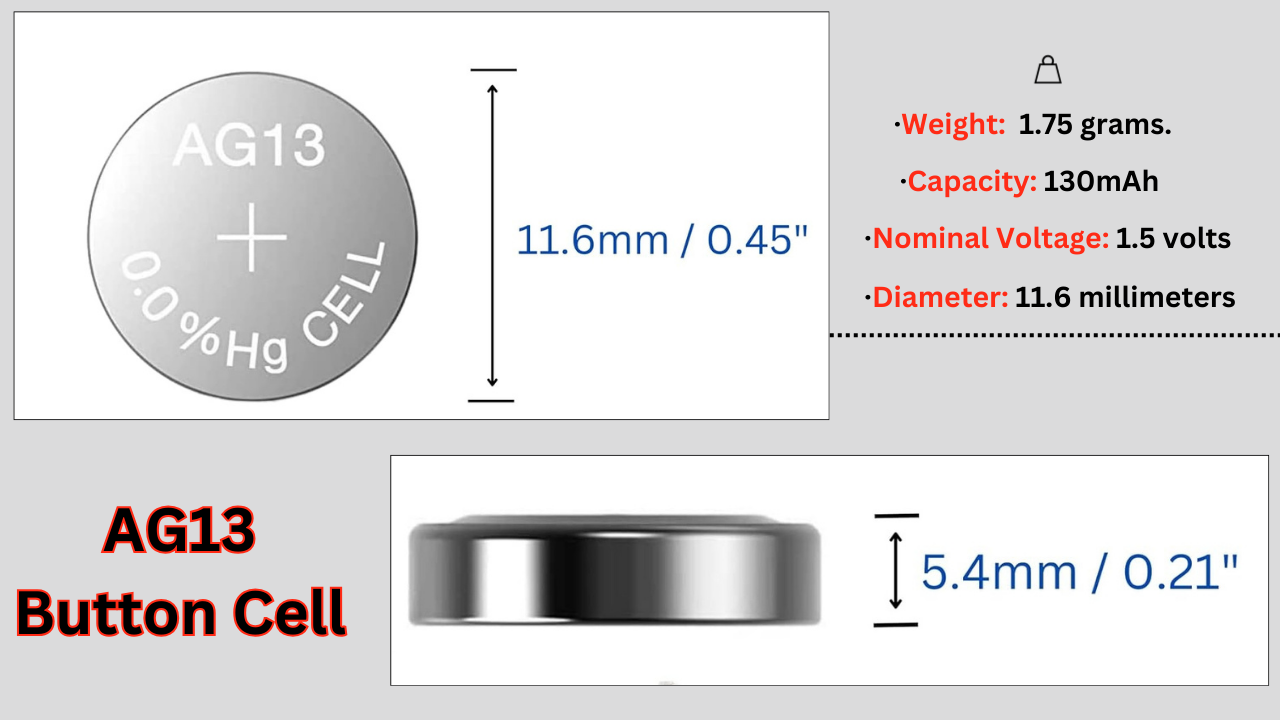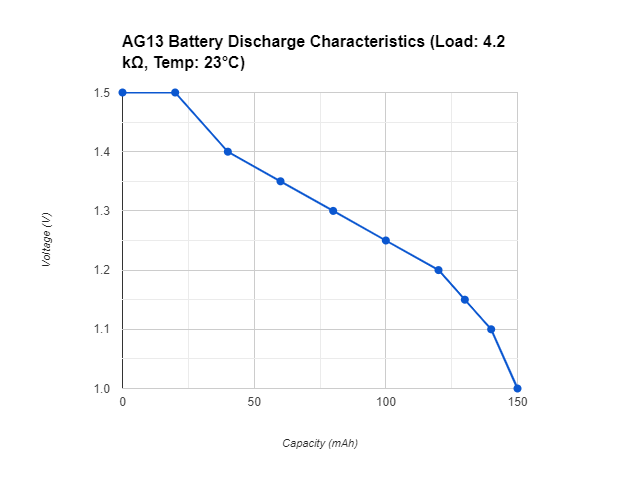Take note of AG13 battery equivalents because when it comes to powering small electronic devices, understanding battery equivalents is crucial. This is because ensuring compatibility is vital for optimal performance.
The AG13 battery is a small, round-button cell battery widely used in various electronic devices. Keep in mind that each type of batter has its own unique chemistry and uses (i.e., Alkaline batteries have different features from Silver-Oxide batteries). However, it's essential to know that different battery types can serve as equivalents despite their unique chemistries and characteristics.
In this article, we will explore the various AG13 battery equivalents, focusing on their specifications and suitable applications. But before we dive into equivalents, let's first start by determining this battery's cell chemistry:
AG13 Battery Equivalents: Understanding Your Options
When looking for AG13 battery equivalents, it is important to recognize the different battery types that can serve you well. This is simply because each battery has unique chemistries and characteristics that, in most cases, make it suitable for specific purposes.
For example, there are electronic devices that want or work efficiently with a stable power source. Therefore, for such cases, you will have to opt for Silver-Oxide Batteries as their nominal voltage is stable, unlike alkaline batteries.
That said, here, common AG13 battery equivalents
· LR44 ~ (Alkaline)
· A76 ~ (Alkaline)
· 157 ~ (Silver-oxide)
· 357 ~ (Silver-oxide)
· SR44 ~ (Silver-oxide)
· L1154 ~ (Alkaline)
· LR1154 ~ (Alkaline)
AG13 Battery Specifications

Commonly referred to as LR44 due to its cell chemistry composition, the AG13 battery is a common button cell battery with unique specifications, including:
Basic Specifications
· Nominal Voltage: 1.5 volts
· Diameter: 11.6 millimeters
· Height: 5.4 millimeters
· Weight: Approximately 1.75 grams.
· Chemistry: Typically alkaline, but silver oxide variants also exist.
Capacity and Discharge Characteristics
· Capacity: Approximately 130mAh (milliampere-hours). This value can fluctuate based on several factors, such as discharge rate and temperature.
· Internal Resistance: This increases as the battery discharges, affecting performance. Higher internal resistance leads to greater voltage drop under load.
· Discharge Curve: The voltage gradually decreases as the battery is used. The end-of-life voltage is typically around 0.9 volts.
Performance Factors
· Temperature: Battery performance is influenced by temperature. Cold temperatures reduce capacity and increase internal resistance, while high temperatures can accelerate self-discharge and shorten battery life.
· Discharge Rate: Higher discharge rates lead to lower capacity. This issue is due to increased internal heating and resistance.

· Self-Discharge: Even when not in use, batteries gradually lose charge over time. This process is known as self-discharge, and factors like temperature and battery chemistry influence it.
Additional Considerations
The recommended operating temperature for this AG13 battery is between -10°C to 60°C. But keep in mind that its optimal performance is often achieved within a narrower range. When storing it, ensure it is in a cool, dry place below 25°C for extended shelf life.
ALSO READ: CR2025 vs CR2032: comparision & features, which is better?
AG13 Battery Manufacturers
· Duracell
· Energizer
· Sony
· Renata
· Maxell
· Panasonic
AG13 Battery Applications
· Watches: It can be used in both digital and analog watches.
· Calculators: It is a reliable power source for small electronic calculators.
· Toys: These batteries are frequently used in small electronic toys with sound or light functions.
· Medical Devices: AG13 batteries are commonly used in hearing aids, blood glucose meters, and thermometers.
· Laser Pointers: The compact size and stable voltage (i.e., Silver-oxide AG13 equivalent batteries) make them ideal for laser pointers.
Battery Cell Chemistry
Generally, button cell batteries are divided into four distinct groups, each defined by its unique chemistry. These groups include:
1. Alkaline Batteries
2. Silver-Oxide Batteries
3. Zinc-Air Batteries
4. Mercury Oxide Batteries
1. Alkaline Batteries
Alkaline batteries are definitely the most commonly used types of cell batteries in everyday devices such as watches, calculators, etc. Most AG13 equivalents come from this group. Alkaline batteries' voltage tends to drop over time despite batteries having a stable performance. This drop can be a disadvantage as it can affect device operation.
Another point to note is that alkaline batteries utilize zinc oxide as the negative electrode and manganese dioxide as the positive electrode.
Key Characteristics
· Nominal Voltage: 1.5V
· Endpoint Voltage: 1.0V
· Capacity: Typically, between 110-130mAh
Some notable alkaline equivalents for AG13 include:
· A76
· 76A
· LR44
· L1154
· LR1154
Alkaline batteries are, therefore, fit for low to moderate-drain devices, such as small electronic toys, watches, and calculators.
ALSO READ: Comparing Different Button Cell Batteries LR44, AG13, LR1154 and More
2. Silver-Oxide Batteries
When considering AG13 equivalents, silver-oxide batteries are another ideal option. The good thing about this type of battery is that it provides a more stable voltage output than alkaline batteries. Therefore, this feature specifically makes them ideal for electronic devices that require steady power delivery.
Key Characteristics
· Nominal Voltage: Approximately 1.55V
· Capacity: Typically, between 150-200mAh
Some common silver-oxide equivalents include:
· 157
· 357
· SR44
· SR44W
· SR44SW
So, if you have high-drain devices where a constant voltage is essential, such as high-performance watches, medical devices, and cameras, then these batteries will particularly be beneficial.
3. Zinc-Air Batteries
If you run devices that utilize low voltage but require larger capacity, then Zinc-air batteries are primarily the ideal option. Their operational voltage range being within 1.4-1.45V makes them suitable for specific uses.
Key Characteristics
· Nominal Voltage: 1.4-1.45V
· Capacity: Typically, between 600-700mAh
Common batteries include:
· 675
· ZA675
· PR44
· Blue Tab
Therefore, if you're looking for an ideal battery for devices that have long run times and high capacity, zinc-air batteries will be beneficial.
4. Mercury Oxide Batteries
This type of battery is hard to find nowadays since they have largely been phased out of the market due to environmental and health concerns. These types of batteries are also considered equivalents to AG13 batteries.
Key Characteristics
· Nominal Voltage: Approximately 1.35V
· Capacity: Typically, between 180-200mAh
The common batteries under this group were labeled as:
· MR44
· MR1154
To Wrap It Up!
Understanding different AG13 battery equivalents is essential for selecting the right power source for devices. Alkaline batteries offer stable performance for low-drain applications. Silver-oxide batteries, on the other hand, provide consistent voltage for high-drain devices while Zinc-air batteries serve specific needs in hearing aids.
And so, it is essential to review and understand the specific type of AG13 battery equivalent to go for.







